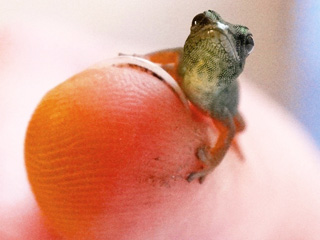Endangered geckos bred at Cotswold Wildlife Park

The Reptile team at Cotswold Wildlife Park is celebrating the arrival of three Electric Blue Gecko babies. It is the first time the Park has successfully bred this species. Electric Blue Geckos (Lygodactylus williamsi) are only found in a small area in Tanzania and are classified as Critically Endangered by the IUCN (International Union for Conservation of Nature).
Survival for these striking creatures in the wild is fraught with peril. They inhabit less than eight square kilometers of the Kimboza Forest in Tanzania, within which they exclusively dwell in the leaf crowns of one specific tree (Pandanus rabaiensis). Tragically, these beautiful Lizards are in high demand from the illegal pet trade, which alone wiped out at least 15% of the population in Kimboza Forest between 2004 and 2009 (Flecks et al. 2012). Illegal collectors cut down the Pandanus rabaiensis trees to collect the rare Geckos, destroying their delicate habitat and population numbers at the same time. They also face severe habitat loss from illegal logging, agricultural demands and climate change. Based on a recent study, this species is considered to be threatened with extinction* in the near future.
Curator of Cotswold Wildlife Park, Jamie Craig, commented: “Our specialist Reptile department have been working on perfecting their husbandry techniques with this species and these hatchlings are an excellent reward for their dedication. It is a real achievement for the Park and we are continuing to get eggs and have a high success rate.”
They are a brand new species to the Park. Not long after their arrival, the Reptile team noticed tiny eggs in the corner of their off-show enclosure. After approximately sixty to ninety days, three tiny Electric Blue Geckos hatched. The babies are healthy and currently off-show in climate-controlled incubators.
Most Geckos are active at night but Electric Blue Geckos are diurnal (active during the day). Geckos are one of the most diverse groups of Lizards on earth and are an incredible example of animal engineering. The ribbed flesh on their toes enables them to scale vertical surfaces - even polished glass. Engineers with the US Department of Defence's research project, DARPA, have been looking into creating 'bio-inspired' gloves for soldiers based on the Gecko’s ribbed toes. In 2014, a study published in the Journal of Applied Physics unravelled some of the complexity of how Geckos can turn their superlative stickiness on and off. This new research is helping scientists to develop technology to enable robots to climb walls or grab onto objects**
More about Electric Blue Geckos:
- This species is endemic to Tanzania and is found within the Forest Reserves of Kimboza and Ruvu.
- Adult males are brilliant blue in colour (pictured right) and the females are green.
- Courtship behaviour is believed to included head bobbing, puffing out of the throat pouch and face licking.
- Two to three weeks after mating, the female lays a clutch of one or two pea-sized white eggs, which she glues to a surface in a secure, hidden location. These eggs will hatch in approximately sixty to ninety days.
- Geckos are the only Lizards that vocalise. The very name - Gecko – is based on the calls of one species. They croak, quack, and cheep. A South American species from the Amazon even barks like a dog. There are more than 1,500 species of Gecko.
Cotswold Wildlife Park is open everyday from 10am.
Burford, Oxon OX18 4JP
Explore Gloucestershire
17 February 2015
For further information.
OTHER NEWS
